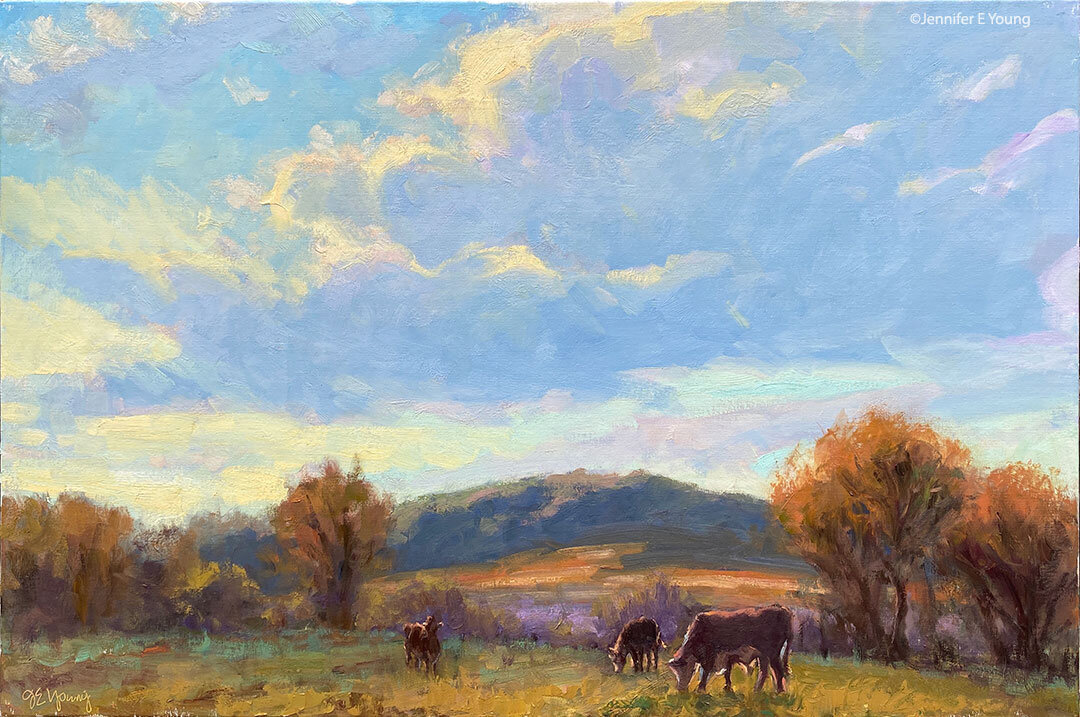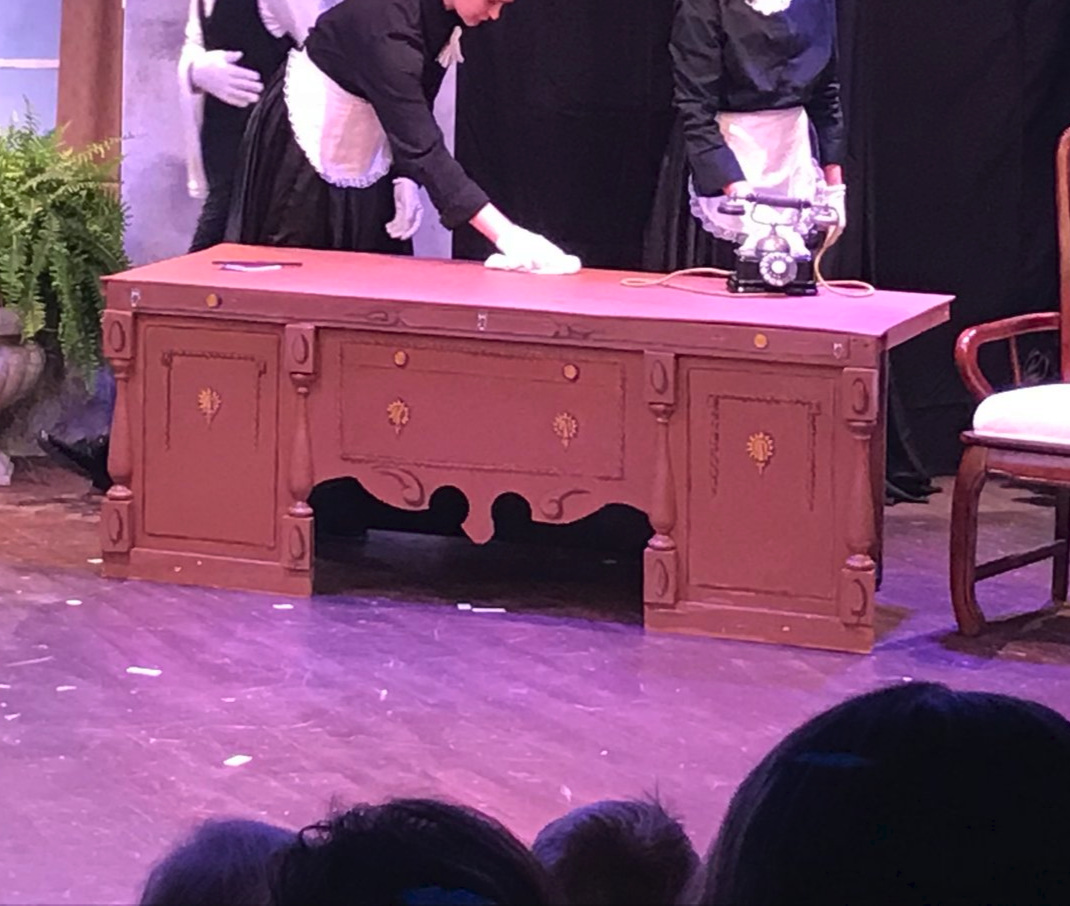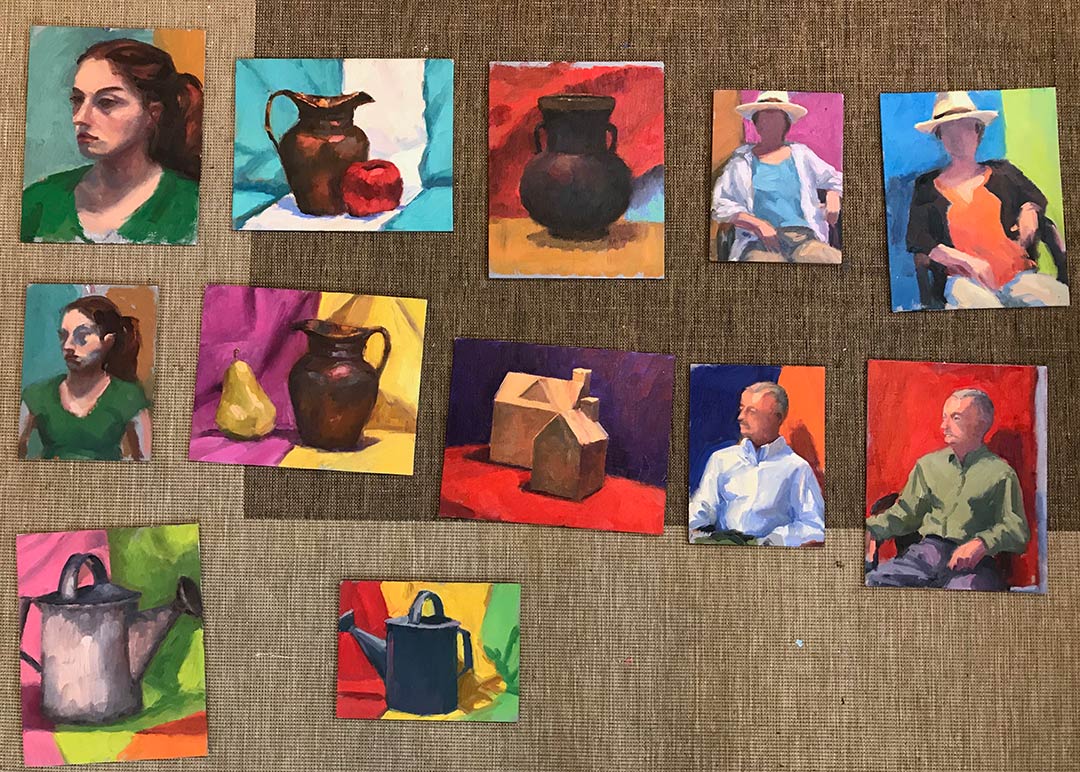In my last post I mentioned Kevin Macpherson's latest book, Landscape Painting Inside & Out . This is a nice companion to his first wonderful book Fill Your Oil Paintings With Light and Color
. This is a nice companion to his first wonderful book Fill Your Oil Paintings With Light and Color .
The latter focuses primarily on plein air painting, while the former encompases both plein air and studio work. In his newest book, the author does a pretty thorough job of describing his supplies and tools of the trade for both his permanent studio and his portable one. Personally I really enjoyed the photos he's included of his indoor studio, (which is dreamy!) as it gives the artist (who likes to dream) some good ideas about how to plan a good setup. It was interesting for me to see that he puts his taboret in front of his easel, so that his color mixing palette is directly in front of him rather than off to the side, mimicking the setup one would have on a smaller scale outdoors. I work in the exact same way, with a mini-taboret on wheels my husband rigged up for me using a small laundry cart.
.
The latter focuses primarily on plein air painting, while the former encompases both plein air and studio work. In his newest book, the author does a pretty thorough job of describing his supplies and tools of the trade for both his permanent studio and his portable one. Personally I really enjoyed the photos he's included of his indoor studio, (which is dreamy!) as it gives the artist (who likes to dream) some good ideas about how to plan a good setup. It was interesting for me to see that he puts his taboret in front of his easel, so that his color mixing palette is directly in front of him rather than off to the side, mimicking the setup one would have on a smaller scale outdoors. I work in the exact same way, with a mini-taboret on wheels my husband rigged up for me using a small laundry cart.
Subsequent sections touch on the different qualities of light and their effect on your subject, as well as value relationships and shape relationships. He has an interesting way of explaining the importance of describing elements in the landscape in terms of shape rather than rendering every minute detail. Here the book shows various black and white silhouettes to explain that an accurate contour is what describes an object. For example, one should be more concerned with the shape of a tree and largely indicate this  as one mass, using details such as individual leaves sparingly and just to accent and better define the subject.
This book touches on a lot of different concerns for the landscape painter. Aside from the ones I mentioned above, the author addresses edges, color temperature, and includes a very interesting section on planning and designing the painting. Several of these subjects are covered in just one or two pages, but they are well articulated and will give the serious landscape painter a starting point for further investigation.
After this overview comes what I consider the "meat" of the book--a large section on painting outside on location and another substantial one on translating your outdoor studies into larger studio works. In these sections, as in his previous book , Macpherson provides several very well described demonstrations of his processes. These sections appeal to me very much. I personally love demos, as it is easier for me to understand visually than it is having it explained.
, Macpherson provides several very well described demonstrations of his processes. These sections appeal to me very much. I personally love demos, as it is easier for me to understand visually than it is having it explained.
What is particularly interesting to me about this part is the way the author encourages experimentation. He includes a few demos using different limited palettes that give the reader some ideas--Â experimenting with an earth primary palette, using a strong color palette, or using a set palette with a monochrome (grey) underpainting.
Different from his last book, Macpherson includes a final section on "The Path to Success". This is really a topic worthy of an entire book (or a series of books). Macpherson goes into no detail at all about how to manage one's art career, but merely touches on some things to think about. Largely he writes about things like being inspired, doing what you love, setting goals, blah blah blah. Sure, all of this is important, but it's dealt with in a pretty vague manner and personally this is the least informative section of the book which covers about the last 15 pages. I suppose it is really just meant to be inspiring, so as long as you don't expect more, you may really enjoy this part.
Overall, this is a very interesting book  with some very beautiful color reproductions of the artist's lush, impressionistic paintings. The demos are good, and I like that the breakout topics are geared more towards experienced painters who might be looking to experiment or deepen their understanding of landscape painting. Macpherson does do a good bit of selling of his other products, such as his other book, video and his "Kevin Macpherson Plein Air Palette" and "Kevin Macpherson Prochade Kit". But this to me is only mildly annoying because I'd probably do the same thing if I offered these kinds of products. ;-) And heck! It must have worked...I've ordered his Prochade Kit for myself and will probably blog about it once I've had a chance to try it out.
 with some very beautiful color reproductions of the artist's lush, impressionistic paintings. The demos are good, and I like that the breakout topics are geared more towards experienced painters who might be looking to experiment or deepen their understanding of landscape painting. Macpherson does do a good bit of selling of his other products, such as his other book, video and his "Kevin Macpherson Plein Air Palette" and "Kevin Macpherson Prochade Kit". But this to me is only mildly annoying because I'd probably do the same thing if I offered these kinds of products. ;-) And heck! It must have worked...I've ordered his Prochade Kit for myself and will probably blog about it once I've had a chance to try it out.





 . This is a nice companion to his first wonderful book
. This is a nice companion to his first wonderful book 
 One of my favorites from this period
"Faith", Oil on Canvas (sold)
One of my favorites from this period
"Faith", Oil on Canvas (sold)












